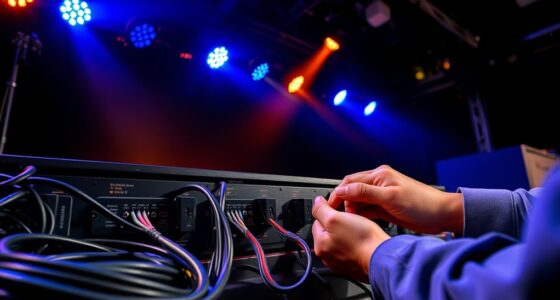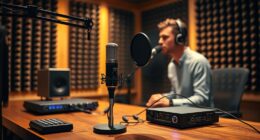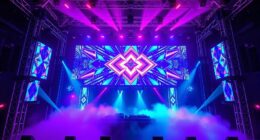To keep lighting and audio cues in sync, plan your cues carefully using a master clock or cue list, and rehearse multiple times to build confidence. Communicate clearly with your technical team, test all triggers beforehand, and establish reliable signals for cue execution. Always prepare backup options and stay attentive during rehearsals to identify and fix timing issues. Mastering these steps guarantees a smooth flow—there’s much more to discover to perfect your coordination skills.
Key Takeaways
- Use a master clock or cue list to coordinate timing across lighting and audio cues.
- Practice multiple rehearsals to build familiarity and identify potential timing issues early.
- Establish clear communication protocols and signals with the technical team for cue triggers.
- Test all cue connections and triggers thoroughly before performances to ensure reliability.
- Prepare backup plans and monitor cues during rehearsals to make real-time adjustments and prevent mismatches.

Lighting and audio cues are fundamental tools that can transform a performance, event, or presentation by guiding audience attention and enhancing emotional impact. When you’re working behind the scenes, understanding how to stay in sync with these cues is essential for a seamless experience. The key to achieving this lies in mastering stage timing and cue coordination. Proper timing ensures each cue triggers at precisely the right moment, creating a fluid flow that keeps your audience engaged and immersed. Cue coordination involves aligning lighting and audio cues so they complement each other perfectly, avoiding any jarring or distracting overlaps.
Lighting and audio cues are vital for seamless, engaging performances through precise timing and coordination.
To stay on top of stage timing, you need a clear plan and reliable timing sources. Many productions use a master clock or a cue list that details when each cue should happen. This acts as your roadmap, helping you anticipate and prepare for upcoming cues. Practice is indispensable; run through the sequence multiple times to build confidence and identify potential timing issues. When you’re familiar with the flow, you can make real-time adjustments if something is slightly off, ensuring cues happen smoothly without noticeable delays.
Cue coordination requires close communication with your technical team. You should establish clear signals and protocols for cue execution. For instance, if an audio cue is synchronized with a lighting change, both must be triggered simultaneously. This might involve using automated cues driven by a lighting console or soundboard, or manual cues managed by operators. Whichever method you choose, it’s crucial to double-check connections and test triggers beforehand. Consistent rehearsals allow everyone to understand their roles and ensure cues happen in the right order and at the right time.
Timing and coordination also extend to contingency planning. Despite meticulous preparation, glitches can occur. Having backup plans or manual override options can save the moment if automated systems fail. During rehearsals, pay close attention to how cues interact and how long they take to execute. If you notice delays or overlaps, communicate these issues immediately and adjust your timing or cue placement accordingly. Additionally, understanding stage timing and how it affects overall flow can help prevent misalignments and improve the audience experience.
Staying in sync isn’t a one-time effort; it’s an ongoing process of refinement. As your production progresses, continue to monitor cues, make adjustments, and communicate openly with your team. When you master stage timing and cue coordination, you create a polished performance that feels effortless and engaging. Your audience will be drawn into the story, never distracted by technical hiccups or mismatched cues. In the end, precision in timing and seamless cue coordination are what elevate a good show into a memorable experience.
Frequently Asked Questions
How Do I Troubleshoot Synchronization Issues During a Live Performance?
To troubleshoot synchronization issues during a live performance, first check for timing errors and signal latency. Make certain your lighting and audio systems are properly connected and configured. Use a test cue to identify lag or misalignment, then adjust timing settings or latency compensation features. Keep equipment updated and minimize cable lengths to reduce signal delay. Regularly monitor the system during the show to catch and correct issues promptly.
What Equipment Is Best for Syncing Lighting and Audio Cues?
Think of your setup as a well-conducted orchestra—lighting controllers and audio interfaces are your maestros. To keep everything synchronized, choose reliable lighting controllers like DMX systems and high-quality audio interfaces with low latency. These devices ensure smooth communication between cues, preventing any discord. When paired correctly, they act like a harmonious duet, letting your performance flow seamlessly without missing a beat.
Can Remote Control Be Used Effectively for Cue Synchronization?
Yes, remote controls can be very effective for cue synchronization. Using wireless remotes allows you to trigger lighting and audio cues precisely, ensuring perfect cue timing. With a reliable remote system, you can easily coordinate changes without delay or miscommunication. Just make sure your wireless remotes are compatible with your equipment and tested beforehand, so you maintain seamless synchronization during your performance or event.
How Do I Ensure Cues Stay Synchronized Across Multiple Venues?
To keep cues synchronized across multiple venues, focus on maintaining timing precision and signal integrity. Use a centralized control system that sends consistent signals to all locations, and make sure your equipment is compatible and reliable. Regularly test and calibrate your setup before each show, and consider redundant connections to prevent signal loss. Clear communication among staff also helps maintain synchronization and prevents delays.
What Are Common Causes of Cue Desynchronization in Complex Shows?
Ever feel like your cues are playing hide and seek? Common causes of cue desynchronization include inconsistent cue timing, technical glitches, and human error. When equipment isn’t calibrated properly or if there’s a lag in communication between systems, cues can fall out of sync. You can prevent this by thoroughly testing your setup, maintaining equipment regularly, and having clear communication protocols. Staying vigilant keeps your show running smoothly, like clockwork.
Conclusion
Staying in sync with lighting and audio cues keeps your performance seamless, like a well-choreographed dance. When everything aligns perfectly, it’s like a whisper in the dark—subtle yet powerful. But when cues fall out of sync, the magic fades, revealing the cracks. Embrace the challenge of precision, knowing that the harmony you create is what transforms a simple show into an unforgettable experience. In this balance lies the true art of enthralling your audience.










